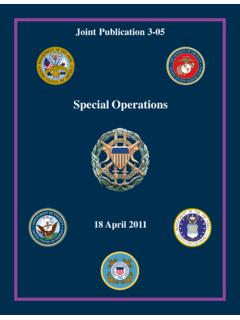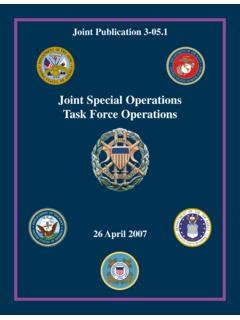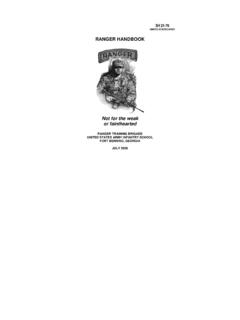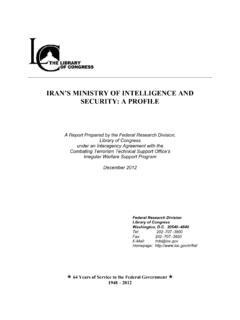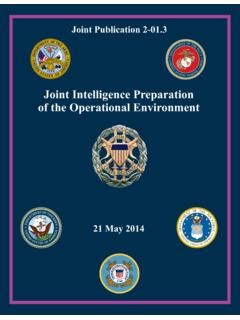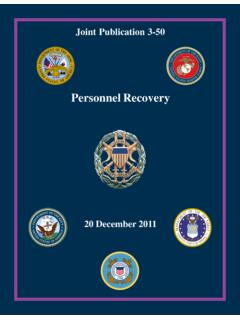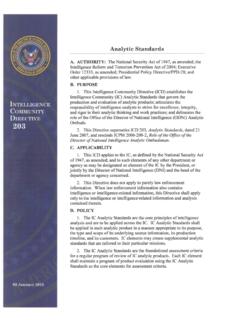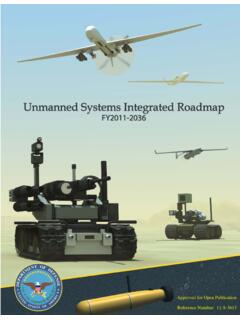Transcription of Guide to Nongovernmental Organizations for the Military
1 Guide Nongovernmental to Organizations for the Military A primer for the Military about private, voluntary, and Nongovernmental Organizations operating in humanitarian emergencies globally edited by Lynn Lawry MD, MSPH, MSc Guide to Nongovernmental Organizations for the Military A primer for the Military about private, voluntary, and Nongovernmental Organizations operating in humanitarian emergencies globally Edited and rewritten by Lynn Lawry MD, MSPH, MSc Summer 2009. Originally written by Grey Frandsen Fall 2002. The Center for Disaster and Humanitarian Assistance Medicine (CDHAM). Uniformed Services University of Health Sciences (USUHS). International Health Division Office of the Assistant Secretary of Defense (Health Affairs). Department of Defense Copyright restrictions pertain to certain parts of this publication. All rights reserved.
2 No copyrighted parts of this publication may be reprinted or transmitted in any form without written permission of the publisher or copyright owner. This pdf document is compatible with Adobe Acrobat Reader version and later. The file may open in earlier versions, but will not necessarily appear as it was designed to appear, and hyperlinks may not function correctly. Acrobat Reader is available for free download from the Adobe website Contents About 5. About OASD(HA) 6. 7. Acronyms and 8. Part 1. NGO Structures and Themes Chapter 1. Policies and Definitions Related to Aid, Relief, and 13. Chapter 2. Introduction to 25. Chapter 3. What Is an NGO?.. 30. Chapter 4. NGO Structure, Authority, and 40. Chapter 5. NGO Personnel and 49. Chapter 6. NGO 64. Chapter 7. NGO 87. Chapter 8. NGO Identification and 95. Part 2. NGO Capacities and Services Chapter 9.
3 NGO Emergency Deployment and Chapter 10. Scale and Scope of NGO Chapter 11. NGOs and Health Chapter 12. NGOs and Food and Chapter 13. NGOs and Water, Sanitation, and Chapter 14. NGOs and Part 3. NGO Operations Chapter 15. NGO Chapter 16. NGO Use of Information and Communications Chapter 17. NGOs and Chapter 18. NGOs and the Part 4. annexes Annex 1. Selected Annex 2. Selected Humanitarian Annex 3. Selected Humanitarian Annex 4. Code of Annex 5. How the Government Provides Humanitarian Annex 6. Red Cross and Red Crescent Systems Annex 7. Key United Nations Annex 8. M decins sans Fronti res speach at Annex 9. About CDHAM: Advancing medicine in humanitarian and disaster relief The vision: To contribute to national security by achieving regional and global stability through health care diplomacy. The Military has a long history of responding to disasters and participating in humanitarian assistance missions.
4 Until recently, however, these missions were considered less important than traditional combat and combat support missions. Events in the 21st century have made it clear that our national security depends on stability around the globe. This was emphasized in recent Department of Defense (DOD) guidance establishing stability sperations, including humanitarian assistance and disaster response (HA/DR), as missions with a priority equal to combat operations. The mission: To provide support to Department of Defense agencies, through education & training, consultation, direct support and scholarly activities, regarding the role of health care in response to disasters and humanitarian assistance missions. The Center for Disaster and Humanitarian Assistance Medicine (CDHAM) was formally established at the Uniformed Services University of the Health Sciences (USUHS) by the Defense Appropriations Act of 1999.
5 Organized within the Department of Military and Emergency Medicine at USUHS, CDHAM is postured as the Defense Department's focal point for academic aspects of medical stability operations. The successful delivery of aid depends on a coordinated effort between the host nation, United Nations agencies, other governmental Organizations , and many NGOs. With respect to HA/DR. missions, the DOD will function in a supporting role to other agencies, such as the Department of State and the Agency for International Development. Effectiveness requires achieving synergy by optimizing each participant's relative strengths. Although the primary target audience for this Guide to Nongovernmental Organizations for the Military , 2nd edition, is the Department of Defense, it is intended to be a practical source of information about many NGOs for the entire humanitarian assistance community.
6 It is hoped that it will also serve as a bridge to better understanding and cooperation. I would like to recognize Dr. Lynn Lawry for her efforts revising this Guide as an author and the senior editor. Without her expertise and dedication, it would not be the quality product it is. It is also appropriate to recognize the work done by Mr. Grey Frandsen as author of the initial Guide . Charles W. Beadling, MD, FAAFP, IDHA, DMCC. Director, Center for Disaster and Humanitarian Assistance Medicine Department of Military and Emergency Medicine Uniformed Services University of the Health Sciences A Guide to NGOs for the Military 5. About the International Health Division OASD(HA)-IHD. The International Health Division (IHD) advises the assistant secretary of defense (Health Affairs) on policy related to interaction of the Military health system with host nation civilians and their health infrastructure in stability operations, counterinsurgency, and humanitarian assistance/disaster response.
7 The IHD is supervised and resourced by the deputy assistant secretary of defense for force health protection and readiness. In accordance with DOD instructions, IHD is committed to partnerships in policy with NGOs, the Interagency, allies, private groups and others. IHD identifies gaps in knowledge, policy and capabilities, and informs OASD(HA)'s continuous quality improvement to meet the challenges of disaster response, complex emergencies, fragile states, and conflict zones. In these circumstances, DOD recognizes it is rarely the health lead except by default; however, MHS must be able to effectively support other agencies and, when necessary, take lead in areas that are too dangerous or otherwise inaccessible to nonmilitary agencies and assets. A Guide to NGOs for the Military 6. Introduction This book is about Nongovernmental Organizations (NGOs), often referred to as private voluntary Organizations (PVOs), nonprofits, charities, and (humanitarian) aid Organizations .
8 Its aim is to orient the Military with NGOs: their operations, strengths, limitations, budgets, practices, and other characteristics that make them unique actors in a large and dynamic humanitarian community. Every NGO is unique: no two have exactly the same objectives, missions, operating procedures, or capacities. To provide a cohesive body of information, generalizations are often made and detail may be sacrificed. This book has been produced specifically for uniformed services personnel, but it may prove useful to others in understanding some of the Military -specific issues in foreign aid. The annexes in this book play an important part in constructing an understanding of NGOs and the NGO community. Designed as a quick reference, annex 2 is a compilation of the most informative websites highlighted in different sections of the book.
9 Annex 1 covers the basics for NGOs commonly found in humanitarian emergencies around the world and ones the Military are likely to encounter. In addition, a more comprehensive and searchable database of NGOs can be found at This publication was initially written in the spring and summer of 2002 by Grey Frandsen, at the time a project officer for CDHAM and a graduate student at the Johns Hopkins University School for Advanced International Studies (SAIS). Mr. Frandsen served as special assistant to Ambassador Carlos Pascual, who headed the Office of the Coordinator for Reconstruction and Stabilization (S/. CRS) at the State Department, and S/CRS advisor on NGO- Military relations. Using the original text as a Guide , the book was rewritten and updated in 2009. Many people contributed to this effort and are designated as authors in the chapter they wrote or edited.
10 Additional editorial help came from Jennifer Espititu MD, MPH (UNC-Chapel Hill), Warner Anderson (IHD), Charlie Beadling, and Kevin Riley (CDHAM). The extensive NGO list in annex 1 was researched and written by Kristen Saenger and Helen Barnhardt, both first-year medical students at Uniform Services University of the Health Sciences, with the help of Gregg Nakano (CDHAM). We are grateful to everyone who helped in this revision. This publication was funded and published by the Center for Disaster and Humanitarian Assistance Medicine, but does not express the opinion, findings, or position of CDHAM, the Uniformed Services University system, or the Department of Defense. For feedback, suggestions, or additions, contact Dr. Lynn Lawry at A Guide to NGOs for the Military 7. Acronyms and Abbreviations1. ACF Action Contre la Faim (Action Against Hunger).
